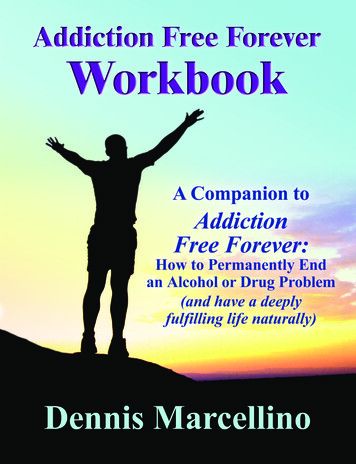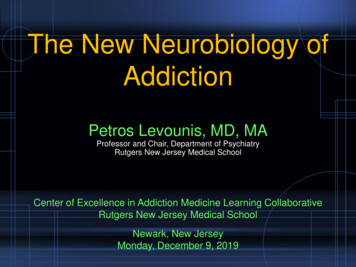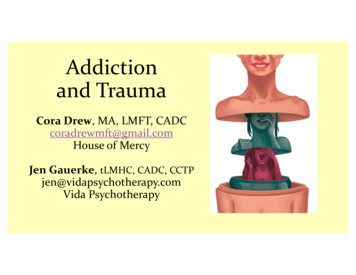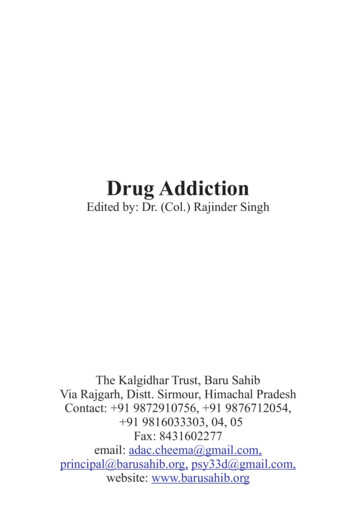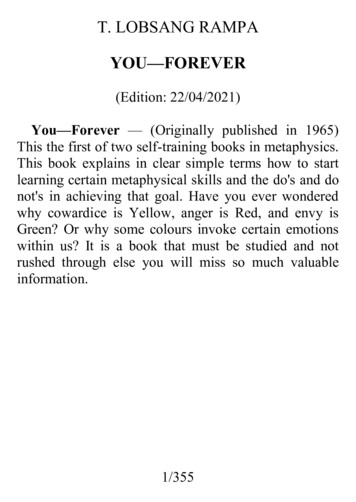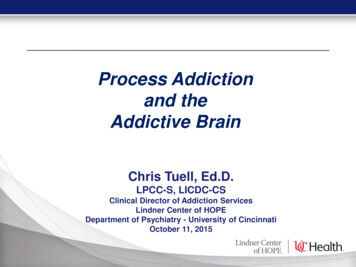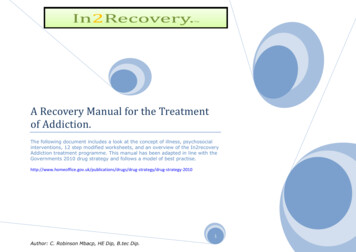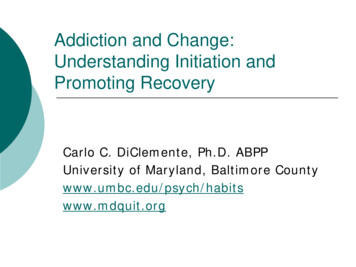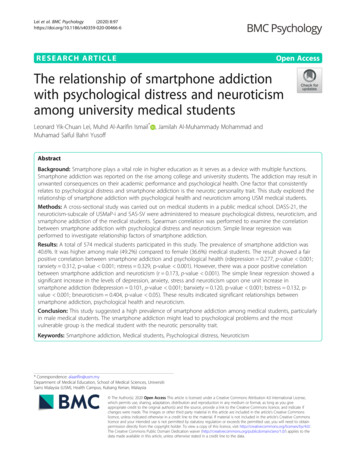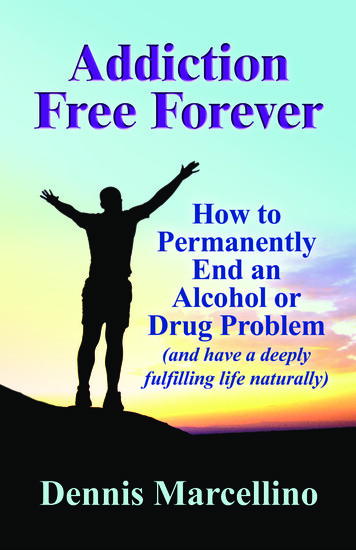
Transcription
Addiction Free ForeverCopyright 2007 by Dennis MarcellinoPrinted in the United States of AmericaAll rights reserved. No part of this book may be reproduced in any form or by any electronic or mechanicalmeans including, but not limited to: Information storage,recording, photocopying, and retrieval systems or by anyother means, without permission in writing from the publisher and author, except by a reviewer, who may quotebrief passages in a review.Published by Lighthouse PublishingP. O. Box 40Gladstone, OR : LighthouseOrders@aol.comSecond EditionISBN-13: 978-0-945272-31-1ISBN-10: 0-945272-31-6
Disclaimer: Although the withdrawal methods in this bookare simple and standard, it is recommended that you confer with a medical doctor who is familiar with your medicalhistory and present condition before you start the withdrawal process so as to determine what your body can safely handle. Please read the full disclaimer and terms of useof this book on page 223 before beginning to read this bookor use any of its advice. This book provides a method foraddiction recovery and recommends supporting materials.It is the sole responsibility and discretion of the reader toact on what is in this book or not. The author, publisher,staff and personnel of Lighthouse Publishing and any of itssubsidiaries shall have neither liability nor responsibility toany person or entity with respect to any loss, damage, orinjury caused or alleged to be caused directly or indirectlyby the use or misuse of the information contained in thisbook. The reader is solely responsible and liable for his/heruse and the consequences thereof as a result of the information herein.
Table Of ContentsR7Read Me FirstChapter 1: Inspiring message from the author9 Author messageChapter 2: Why traditional approaches oftendon’t work as permanent cures and why thisprogram does16 The issue of control19 What is the problem with the willpower andbehavior modification approaches?21 Why this method is more effective andquicker than The 12 Step movementChapter 3: Defining and understanding theproblem of addiction23 What defines an addiction?25 Why people use alcohol and drugs (the 3approaches)30 Two types of addiction: Direct addiction &Cross-addictionChapter 4: Becoming an expert on life andyourself33 Becoming an expert on life and your self
35 The natural design39 The spirituality reality57 Great benefits from taking this approach64 First know thyself65 The 6th sense78 How to be high naturally99 Just to be sure101 Building sensitivity103 Wanted: a shepherd (an ad by the sheep)104 An advanced meditation technique112 The preparation for contemplation114 The 7-second techniqueChapter 5: No longer being a slave to all ofyour feelings or the world117 Habits120 Maintaining peace122 Emotions127 Sex128 The God-void131 Our 'feeling management' approach132 The Serenity Prayer145 The wisdom of discipline vs. feelingsChapter 6: Transition to a natural life154 How to overcome the biggest obstacle totransforming your life160 Who is in control of your life?162 Some great benefits that come from carryingout this program163 How to be happy165 How to get support
Chapter 7: Achieving and maintaining a cleaninner state173 Continued personal growth182 The positive way of looking at God185 Part-time leaderAppendix A195 Getting Through WithdrawalAppendix B207 How big is the drug problem in the UnitedStates?Appendix C210 How this book can even help people whoseem “out of it”211 About the author216 References217 Index221 Support products order page222 Reviews and Quotes
Read Me FirstRThe contents of this book can be absorbed bysome without having to first completely stopalcohol and/or drug use. But if you feel a sense ofurgency about your situation, or you need sharper clarity to completely absorb and carry outwhat’s in this book, then first go to Appendix A(called “Getting Through Withdrawal”) on page195 and start or complete the process of withdrawal from alcohol or drugs.While this book can be used on its own with success, it is also part of a larger overall programcalled the “Addiction Free Forever Program”.The program workbook, called the Addiction FreeForever Workbook, spells out a step-by-step, 10phase, at-home, recovery and life transformationplan. It offers a helpful and supportive way tocarry out what is in this book by starting withassignments that take you through a completeevaluation of your personal philosophy of lifeand life experience. Then it shows you how totransform to an addiction free life where you willhave strength, deep fulfillment and no desire foralcohol or drugs. The Addiction Free ForeverWorkbook and program are available on the webat www.AddictionFreeForever.com/orders.html.
This book is dedicated tothe success of allwho desire, earnestly seekand are willing to work fora clean, joyful, deeply fulfilling lifeand the higher purposesand higher states of human existenceas they naturally manifest.R
Chapter 1An Inspiring Messagefrom the AuthorRThere is something central to all addictions.Observing and understanding that “something”is key to not only ending an addiction,but also to achieving a very happyand deeply fulfilling life.Before I tell you what that “something” is, let mesay that drugs and alcohol, to a normally sensitive person, are too intense experiences and wouldbe rejected by a “normally sensitive” person.So then what do I mean by “normally sensitive”?“Normally sensitive” means being sensitive toand staying in touch with every message thatcomes from your body as to what you should andshouldn’t do with your life and your body.-9-
Chapter 1With that in mind, I can now say thatthe “something” that is central to all addictions is:not being completely who we really are.Sounds simple enough, doesn’t it? Well, as youread on, you’ll see that due to the desires of otherpeople and the world in general and how theywant us to be, and the pressures, criticisms,rewards and punishments they use to try to getus to be the way they want us to be, it is actuallya difficult thing to stay in touch with and maintain who we really are. (But I will be showingyou something that will make that possible.)What makes this an all the more difficult thing is:due to years of these pressures and “successful”attempts by others to train us, there often aremany layers of self-enforced repression nowcovering our ability to be sensitive. And thatenforcing is born out of a fear of re-experiencing the pain that we felt when we were initiallywounded. So now we have these barnacles onour heart that have been piled on and glued inplace through trauma and anti-natural trainingover the years since our birth.And now these layers are buried in our subconscious. largely forgotten and now a part of ourautomatic pilot. They automatically prompt usas to what we can and cannot do and feel, without respect for who we naturally are. Thus wehave been trained through pleasure and pain.- 10 -
An Inspiring Message From The Author(By the way, not all training is bad. Yes we mighthave some bad inclinations that we need to stayaway from and eventually retrain. But I’m mainly speaking about how we’ve been trained awayfrom our good natural inclinations.) The problemhere is that most people think that those thingsare who they are because they feel them, and theythink that they are their feelings.But just like a car or a DVD player, if you don’toperate them as they were designed to be operated, they’re not going to work correctly and produce smooth performance. In fact, just like a carmakes funny noises to alert us to the fact thatsomething is wrong and needs fixing, or it givesus a message that something is wrong through alight or gauge on our dashboard, we get uncomfortable feelings to let us know that somethingis wrong in our life or ways and needs fixing.But when a person feels like they can’t respond tothose uncomfortable feelings in a way that will beacceptable to the people in their life, or they don’tknow how to respond to them and do the fixingand can’t find anyone to tell them how, theyoften try to take these messages and sweepthem under a drug so they won’t have to seethem and feel their discomfort.The good news, though, is that we do have ahoming instinct that wants to get us back to ournormal, natural selves. And this homing instinct- 11 -
Chapter 1has a driving energy of its own that won’t bedenied. If it’s not going to be lived out, it musteither be suppressed or sublimated or drugged.But this book is going to show you how to fulfillit (instead of running from it into addictions).And in doing so, all addictions lose their power.When we think and act how we were designedto, a pre-designed range of good feelings arereleased in us, and the bad ones that aredesigned to correct us aren’t released in us. Andone of those good feelings is strength with peace.The other part of the good news here is that yearsof analysis of the darkness within is not required.As a wise teacher once said, if you want to getout of darkness you don’t sit and analyze it,which will just make you feel worse yougrope for the light switch. Because once the lightis on, you won’t even care that there ever wasdarkness because you’ll just be enjoying thelight. as you were naturally made to do.The actor, Woody Allen, who has often made itclear that he was in therapy a lot, comically reiterates what I just said in his movie “Sleeper”. Hegives a critique of how effective he thinks it is toanalyze the darkness to solve problems. In thismovie he was woken after being in a suspendedsleep state for 200 years and said, “Gee, if I wouldhave been seeing my analyst all of this time, Iwould have almost been cured by now.”- 12 -
An Inspiring Message From The AuthorSo in this book, I’m going to show you where thelight switch is and how to turn it on. (That’s akind of “turning on” that is good for you :-).Another piece of good news here is that I speakto you and guide you as someone who wasaddicted to many things for many years and whonow has been addiction free for 24 years. And Idon’t call myself a “recovering” addict, becauseI’m an EX-addict. I’ll show in this book how aperson can achieve the same thing I did.I had to suffer and struggle to find THE curebecause the world didn’t make it readily obviousto me (and I did try MANY different methodsand counselors along the way). So now it pleasesme to make it easier for you, by first giving youhope that a natural and permanent cure reallydoes exist, and then giving you very specificinstructions on how to not only rid yourself ofthe feelings that drive you to addiction, but alsoto show you how to have a deeply fulfilling life ofgreat purpose. And that is a critical part of “thecure” because I recognized early on that youcan’t expect a person to permanently “say no todrugs” unless they find something better to say“yes” to.I mean, a person could be told (and this often isthe message of anti-drug commercials) that whenthey use alcohol and drugs they are toying withthe health of their brain and could possibly- 13 -
Chapter 1impair its ability to function in this life. But thatmessage could be about as effective as telling anoverweight person that by overeating they aretoying with the health of their body.In other words, maybe an overweight person oran alcoholic or drug user doesn’t care about risking hurting their health because they are lookingat their overall life experience and making anoverall decision that a life that includes alcohol,drug or food abuse is better than what they areexperiencing without doing those things.That’s why the purpose of this book is to showhow to have a better overall life, where the decision will naturally be made to not want to have tosuffer the negative impacts of alcohol and drugsbecause frankly they are no longer seen as aids intheir generally healthy life. Their impact wouldbe solely seen and felt as negative and as offeringnothing positive. That is the perspective of mylife now (although for many years it wasn’t).Let me also dispel here a notion that some mightbe having: this method will work for anyone regardless of background, socio-economic status or circumstances. After a while with thismethod, you will understand why that is true.And inherent in what I just said is an importantpart of an addicted person’s transformation –that they understand what they’re doing and- 14 -
An Inspiring Message From The Authorwhy they’re doing it. not just because theybelieve someone else’s words or instructions.It is that understanding that will allow them todifferentiate between the different offerings inthe world, and strengthen their resolve and carrythem through withdrawal, recovery and into agood life.So if an addicted person truly desires to be rid oftheir addiction, the method in this book can satisfy that desire and show them how to be addiction free permanently.- 15 -
Chapter 2Chapter 2Why Traditional Approaches OftenDon’t Work as Permanent Curesand Why this Program DoesRThe issue of “control”If you are reading this book, I presume you areeither a person who has an addiction problem orare someone who is trying to help a person withan addiction problem. Saying that there is anaddiction “problem” is implicitly saying that theaddicted person wants to be different than howthey presently are. That also is implicitly sayingthat they don’t have control over their self.Otherwise they would just choose to changeand there would be no problem anymore.So let me make a very important point here and it’s a point that makes this program differentthan most programs that are available. It startswith the thought that no one has complete control over his or her self. For example, can youstop yourself from dying, getting sick, feeling- 16 -
Traditional approaches vs. this programpain, sleeping, feeling romantic, feeling heartbreak, etc.? No. And for those who think they aretheir body: do you beat your heart, digest yourfood or breathe yourself? No.There are many things that our body does thatwe have no power to resist. That is why merelywishing that we were certain ways is not going tosolve the problem. And that is why willpowerand “just say no” are not the best approaches fora permanent solution to any kind of internalbehavior problem (including addiction).So then, what is? Only a solution that considersall aspects of a person’s physical, mental, emotional, spiritual and social being and how thesolution will affect all of these can be considereda solution. I’m talking about what is sometimescalled a “wholistic” approach (meaning the“whole” being) or a “holistic” approach (whichputs more emphasis on the spiritual aspect).An analogy could be made here of having a problem with your car. For instance, if your carstopped operating properly in a certain way,would willpower or wishing fix the problem?No. You need to take it to a mechanic (or do therepair yourself). Then the mechanic might say“The reason why you ended up with this problem is because you’ve been operating the carincorrectly. If you don’t want this problem in thefuture you need to operate the car correctly.”- 17 -
Chapter 2So that is the essence of this program. You aregoing to learn how to operate your being correctly. And frankly, if you don’t want an addiction problem (or any other internal problem), youultimately have no choice than to take thisapproach. We may try to fight nature’s specificways about how a human being was designed tointernally and externally operate (just like a carwas designed very specifically), but then we areleft with the results of wrong operation. So if wewant good results, we have to be good operators.It is that simple.What makes this a confusing and difficult situation is the fact that the world in general doesn’tcompletely stand for or promote “natural operation”. Even most psychologists and rehab systems don’t understand or promote complete natural operation. But after you read this book, youwill know what natural operation is. And youwill know how to transform to it. And you willknow how to receive the independent internalstrength you need to carry it out, regardless ofwhether the world and other people go alongwith it or not.You need to stop fighting nature, or debatingwith it, or following other people who go againstit. For a person who wants full recovery, there isno other option but this principle. But on the positive side, being in harmony with nature not onlycan eliminate your problems, but nature rewards- 18 -
Traditional approaches vs. this programwith nice and pleasurable feelings those who follow its ways. So being that you are in this realityof not having complete control, it is wise to takethe approach that is going to give you the bestexperience. And after reading this book, you willknow how to do that.And like I said before, I tried many otherapproaches, including the traditionally acceptedones, but none of them worked. Only the one thatI’m about to show you did. (And it’s been working for me for 24 years now).What is the problem with the willpowerand behavior modification approaches?Looking at the diagram, the thing causing theproblem is not the leaks it is the pressure of thewater behind the leaks. Similarly, the problem- 19 -
Chapter 2with a behavior problem is not the behavioritself, it is the pressure that is causing a personto choose the behavior. I mean, if it was just thebehavior that was the problem, a person couldsimply choose to stop the behavior.But what if a person decides that they want tostop a behavior but can’t? Obviously the problemthen reveals itself to be this lack of a wholisticplan as well as the internal strength to be able tocarry out what they want. That is why this program includes showing how to relieve the innerpressures that push a person into dysfunction,as well as how to have the strength and resolveto stay the natural course.Also, like the cartoon shows, if you try to eliminate the inner pressures that lead towards addiction and abuse of the body and mind simply bystopping them, the pressure will find other waysto seek relief. And it’s good to keep in mind thatthe cause of the pressure is not completelypathological. It also receives some of its steamfrom natural drives and the “homing instinct”that is trying to get us to be who we really are.Therefore, some of the pressure can be eliminated, but some of it can’t and must be fulfilled. Thatis part of the recognition that we can never be intotal control. But as you read this book you willbe shown why that is actually a very good thing,- 20 -
Traditional approaches vs. this programand something that you would choose if youcould see and understand the whole picture ofthis process and your life and life itself. Thereforeyou will be shown how to gain the ability to“see” and “understand” all of that.All of what I just said is how we take a wholisticapproach.Why this method is more effective andquicker than the 12 Step movementFirst, let me say that I have a high regard forthose who are in and who are promoting the 12Step movement. And I agree with nearly all of thesteps. But things do advance, and the method inthis book has been said to be more advanced bysome top people in the 12 Step movement for thefollowing reasons.(1) Steps 3 and 11 of the 12 step movement refersto God “as we understood Him”. I understandthat the root of this is probably because that program doesn’t want to exclude anybody or getinvolved in theological debates.Nevertheless, the science of logic tells us thatthere is only one truth. And to the degree that aperson understands and is in harmony withthat truth, is the degree they will be effective intheir recovery and in their life.- 21 -
Chapter 2In the program of this book you will gain anunderstanding of and proof of what THE truth isabout life and God. It won’t be left to you to haveto fish for this truth. But you will not be asked tojust accept or believe anything. It will be fullyproven for your acceptance. And this truthexcludes no one. Just the opposite.(2) Step 11 of the 12 step movement says that theapproach to knowing God’s will and findingstrength is through prayer and meditation. Thatis partly true but not enough. That could be avery long process that could subject a person stillto a lot of experimentation in life that could dragon and not become totally settled for years. Thatwas my experience and the experience of thecommunities that I was involved in that took thatapproach. And a lot of pain and failures happened because of not knowing THE truth duringthat experimenting. This program will show ashortcut on how to know God’s will in generaland the will of God (who is the designer of thenuts and bolts of this existence and being that wefind ourselves in) for every moment of your life.And living in that will is what brings strength.(3) My complete Addiction Free Forever Programcarries a guarantee in the sense that it is based onthe credibility of the Bible and the guarantees in it.But that is something that you may not fullyunderstand and accept until you are well into theprogram. So be patient with realizing that.- 22 -
Chapter 3Defining and Understanding theProblem of AddictionRWhat is addiction?What defines an “addiction”? More specificallywhen does a “normal action” become an “addiction”? That happens when we override the factthat the deepest part of our being either wants usto not do a certain thing or it wants us to do a certain thing and we either continue in doing thething that it doesn’t want us to do, or we don’t dothe thing that it wants us to do and we do something else instead. That “something else” iswhat we can be said to be addicted to.So a simpler phrase could be: addictions arethings we do instead of what we are naturallyinclined to do. Now “naturally inclined” doesn’t- 23 -
Chapter 3mean “everything we feel” because our feelingscan also be triggered by pathological programming in our subconscious. For example, wemight feel like binge eating when in fact thedeeper feeling might be to be romantic or relievestress or express anger, etc.Therefore, an important part of regaininghealth and eliminating addiction is to develop akeen sensitivity to the deepest part of ourbeing.A song once said, “Wonderful is what you’ll feelin you when you do the things you’re made todo.” That means being in harmony with and living out the design of your being and the purpose ofyour life.Another factor is the difference between intoxicating addictions and non-intoxicating addictions. That is, with non-intoxicating addictions westill can be in touch with all parts of our being,including the deepest part. So even though wemay choose to override certain internal messageswith an addictive behavior seeing and acknowledging them is still possible for us, and thereforewe can move in the direction of correcting them.But once we imbibe an intoxicant, we now maskour ability to see all of our internal workings andtherefore lose sensitivity and control over them(which actually is a big reason why people use- 24 -
Defining And Understanding Addictionintoxicants. That is they don’t want to be showncertain feelings that are going on within them -like guilt or hesitance – and be pressured to haveto act on them or let them “ruin their fun”).An example of this would be: the body saying itdoesn’t want to have sex or is not inspiring sexand then using alcohol to override that resistanceor lack of inspiration.Whereas, these natural feelings that are being discounted would lead to an understanding that sexshould only happen within the safe confines of amarriage relationship with a safe, mature, committed partner. Therefore, it isn’t wise to goagainst our natural feelings because their aim isto lead us to a better place. The wisdom is in listening to our true nature and not the mores ofthe culture we find ourselves in. How to do thatwill be taught in this book.Therefore, in order to be able to resolve anyaddiction, there ultimately can be no masks.All Addictions Have This In CommonAll addictions have one of these three approaches in common:Approach #1: Self-medication(1) A natural feeling comes up in a person.- 25 -
Chapter 3(2) The person is not able to naturally resolve it orsatisfy it (either because of an outer block, aninner block, a self-induced block or all of these).(3) They have to sublimate the energy of the natural feeling (which will continue to push untilsatisfied) into a “saccharin” or fake release.(4) The real satisfaction of the feeling doesn’toccur, just an illusory satisfaction in which thenatural feeling was put off for a time (just like“saccharin” puts off a craving for sweets).(5) Also, just like with “saccharin”, the feelingwill eventually become aware that it’s beentricked, (“It’s not nice to fool mother nature”) andit will push for true satisfaction.(6) If the blocks are still there and accepted asunchangeable or irresolvable, the person willcontinue to sublimate the desire for satisfactionwith more “saccharin” substitutes or a heavierdose (hence an addiction). With pornography,most serial rapists and killers said that they started out with a mild pornography addiction thatescalated (e.g. Ted Bundy and Jeffrey Dahmer).(7) The inevitable realization: Not until the needis truly and naturally satisfied will the feelingsubside. This is also why fad diets don’t work.That is, they fill the belly, but do not satisfy thenutritional hunger. So there still is a natural- 26 -
Defining And Understanding Addictionhunger that is waiting to be satisfied in a naturalway. Only then will the hunger feeling go away.Approach #2: Wanting a continual joy rideIn this approach, the person either takes a drinkor uses a drug to have somewhat of a pleasurableexperience kind of like going on a roller coaster.But the problem here is if you ride a roller coaster over and over, you will eventually get sick.Another analogy would be: eating cotton candy.But if you overeat cotton candy, you might get fatand even get diabetes and low blood sugarheadaches.Now a normal, sensitive person will very muchsee the negative signals when using alcohol ordrugs and respond to those signals by stoppingtheir use. But here is another way in which Idepart from the current status quo thinking onalcohol and drug rehab: a little bit of cottoncandy or an occasional roller coaster ride mightbe okay for some (but not for others). Also theymight be okay at one point in a person’s life andnot another. I mean, God did make sugar, andJesus did make wine at the wedding feast.But in any case, overeating sugar or getting drunkare not healthy ways and can lead to some verybad problems. So this program is all about gettingthings into normal functioning. And addiction isnot normal functioning. Therefore, an abuse of- 27 -
Chapter 3“Approach #2” (wanting a continual joy ride)always becomes “Approach #1” (self-medication).For the person who wants a continual joy ride,even though their body and life may at times bescreaming for them to stop, there is an underlying problem that keeps pushing them in thatdirection which is the lack of joy and inspirationin their natural life. So this program (or any program) wouldn’t be able to be considered to bepermanently successful unless it showed how tohave natural joy and inspiration.Therefore, the cure that I will present here willshow how to remove any blocks (inner or outer)that prevent a person from satisfying theirunderlying natural hungers.And what is one of the attractions of a joy ride? Imean, I don’t like roller coasters (chemical oractual) because I’m very sensitive now and havea normal life, so they are shocking and unpleasant experiences to me. But a person can beattracted to this kind of experience if they need avery dramatic shift in how they are seeing,approaching and feeling about life.We can get “stuck” in wrong ways of seeingthings and then not see that we are stuck thatis, unless something comes along to show us that.That “something” can take many differentforms a religious experience, traveling to- 28 -
Defining And Understanding Addictionanother country, a movie, a book, etc. And forsome, that “something” comes in the form ofalcohol or drugs. In this sense there was a VERY“dramatic shift” when I was in my late teens andtwenties where I was living and grew up in SanFrancisco. It was the hippie movement in the late‘60s and the ‘70s. And it involved drugs.I must admit that I learned a lot but I also mustadmit that I suffered a lot almost to the point ofnot surviving it (as many didn’t from among myfellow hippies, especially musicians). So a pointhere with this program is to show how to makethose shifts to a deeply fulfilling and clear lifeby natural and not dangerous means.Approach #3: A weakness to peer pressureIn this approach a person may be just drinking orusing drugs because they are being prodded todo so by their peers and they are too weak to facethe criticism or ostracizing by their (current) peersif they don’t go along. Their feeling of wanting tobelong is causing them to override their naturaldesire to not want to use alcohol or drugs.This was the case for me. My body threw up onboth of my first uses of alcohol and drugs and Icoughed really badly with my first cigarettes. ButI didn’t want to come off as “uncool” or not independent or repressed and not free, so those feelings caused me to continue in smoking and- 29 -
Chapter 3drinking and using drugs. The solution here isobviously choosing new peers. Of course that canbe easier said than done, but it may be a necessity if a person doesn’t want their using to moveinto worse problems. So once again, thisapproach becomes an “Approach #1”, with the“natural feeling” being: a need to belong. So inthe final analysis: all addiction approaches are“Approach #1” which is self-medicating.Two types of addictionThere are two categories of addiction:(1) Direct addiction(2)
addiction recovery and recommends supporting materials. It is the sole responsibility and discretion of the reader to act on what is in this book or not. The author, publisher, . The program workbook, called the Addiction Free Forever Workbook, spells out a step-by-step, 10 phase, at-home, recovery and life transformation plan. It offers a .

